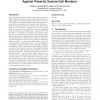CCS
2008
ACM
14 years 1 months ago
2008
ACM
Single-Sign-On (SSO) protocols enable companies to establish a federated environment in which clients sign in the system once and yet are able to access to services offered by dif...
CCS
2008
ACM
14 years 1 months ago
2008
ACM
System-call monitoring has become the basis for many hostbased intrusion detection as well as policy enforcement techniques. Mimicry attacks attempt to evade system-call monitorin...
CCS
2008
ACM
14 years 1 months ago
2008
ACM
The Unified Model (UM) key agreement protocol is an efficient Diffie-Hellman scheme that has been included in many cryptographic standards, most recently in the NIST SP 80056A sta...
CCS
2008
ACM
14 years 1 months ago
2008
ACM
Combinatorial group testing, given a set C of individuals ("customers"), consists of applying group tests on subsets of C for the purpose of identifying which members of...
CCS
2008
ACM
14 years 1 months ago
2008
ACM
Online privacy is an increasingly important problem, as many services are now offered in a digital form. Privacy (or the lack thereof) is of a special concern in subscriptions to ...
CCS
2008
ACM
14 years 1 months ago
2008
ACM
A recent development in formal security protocol analysis is the Protocol Composition Logic (PCL). We identify a number of problems with this logic as well as with extensions of t...
CCS
2008
ACM
14 years 1 months ago
2008
ACM
Virtual machines are widely accepted as a promising basis for building secure systems. However, while virtual machines offer effective mechanisms to create isolated environments, ...
CCS
2008
ACM
14 years 1 months ago
2008
ACM
A practically feasible modification to fixed-priority schedulers allows to avoid timing channels despite threads having access to precise clocks. This modification is rather simpl...
CCS
2008
ACM
14 years 1 months ago
2008
ACM
Data sharing on public servers has become a popular service on the Internet, in which users can store and share data with other users through public servers. However, because the ...
CCS
2008
ACM
14 years 1 months ago
2008
ACM
Wireless communication enables a broad spectrum of applications, ranging from commodity to tactical systems. Neighbor discovery (ND), that is, determining which devices are within...






